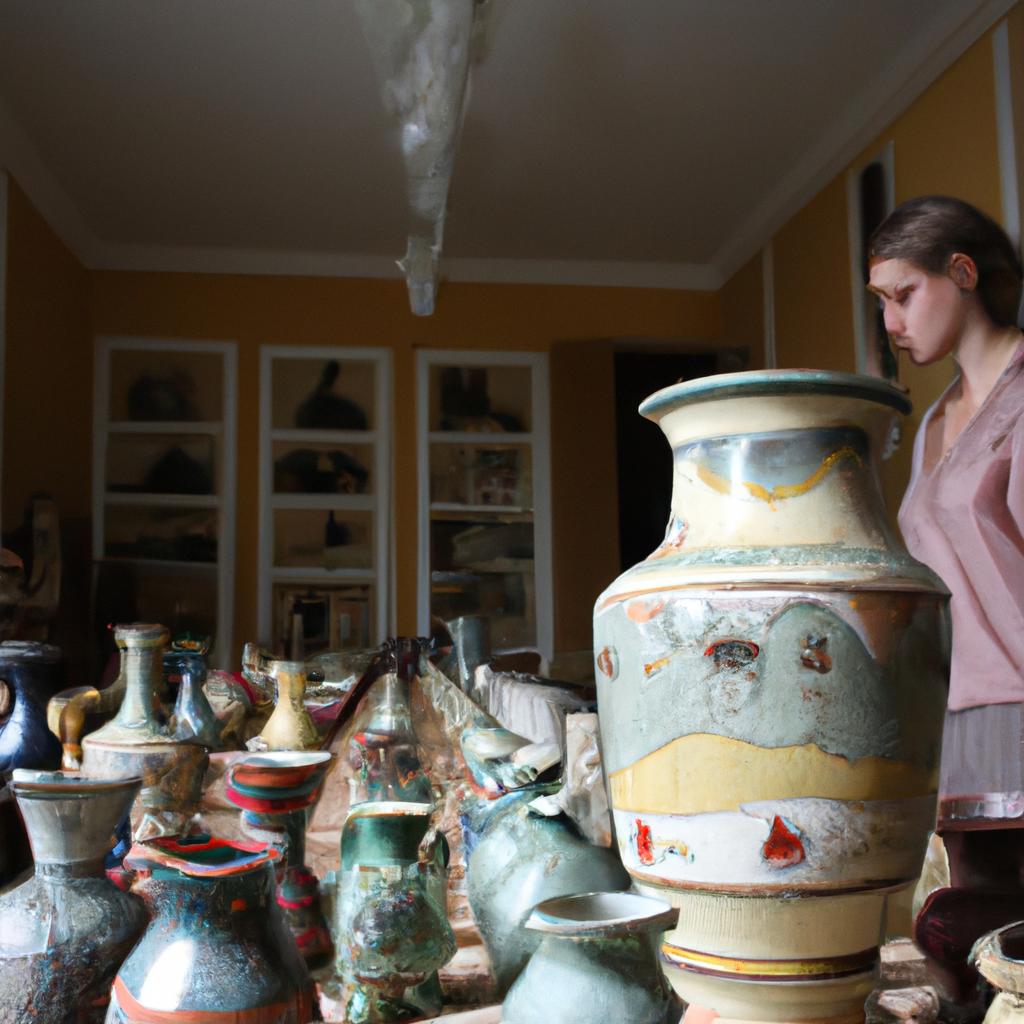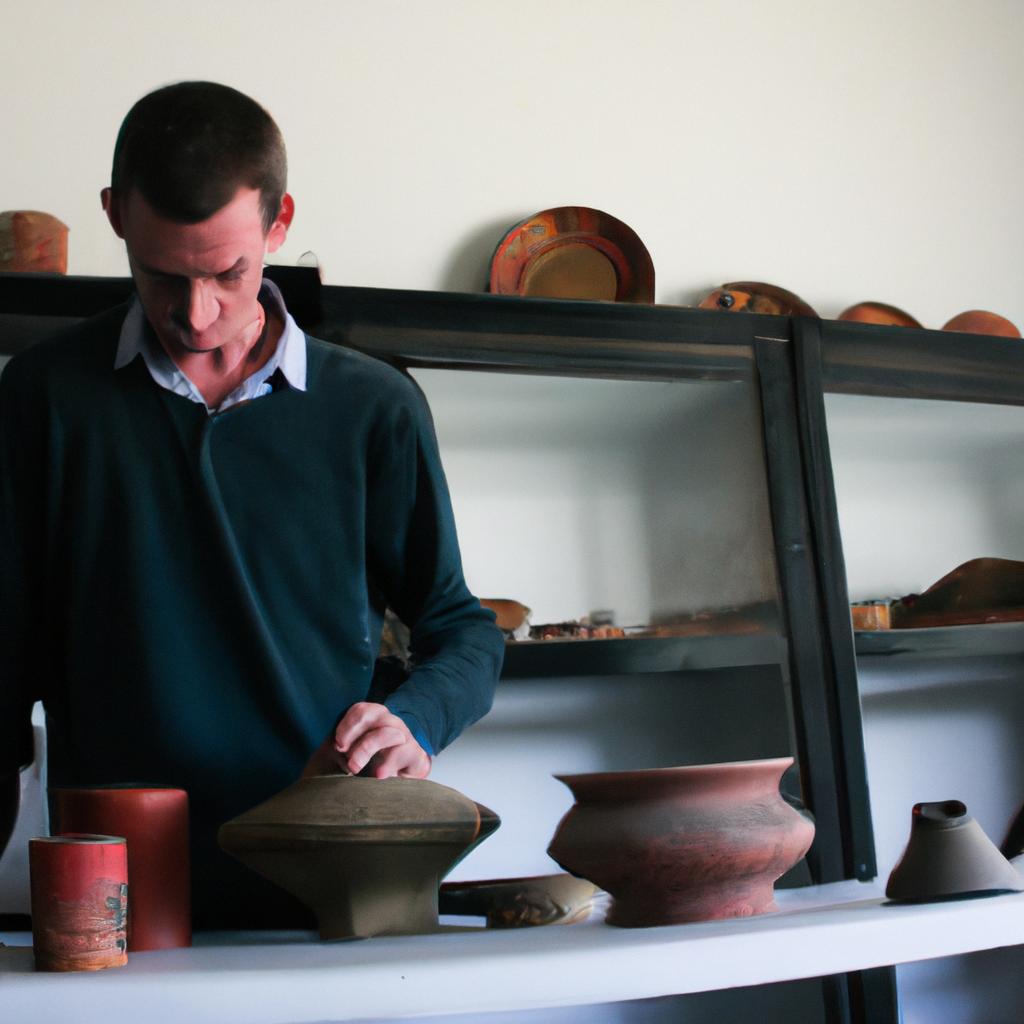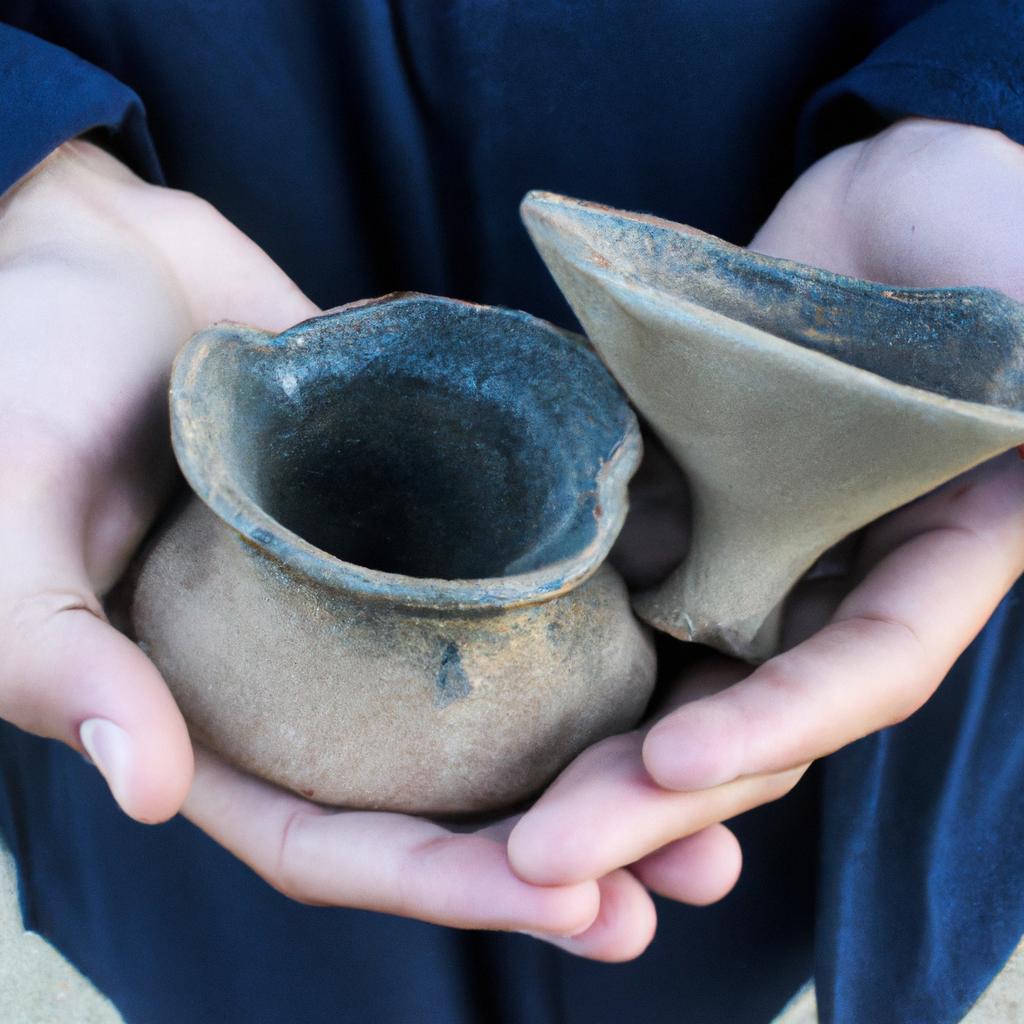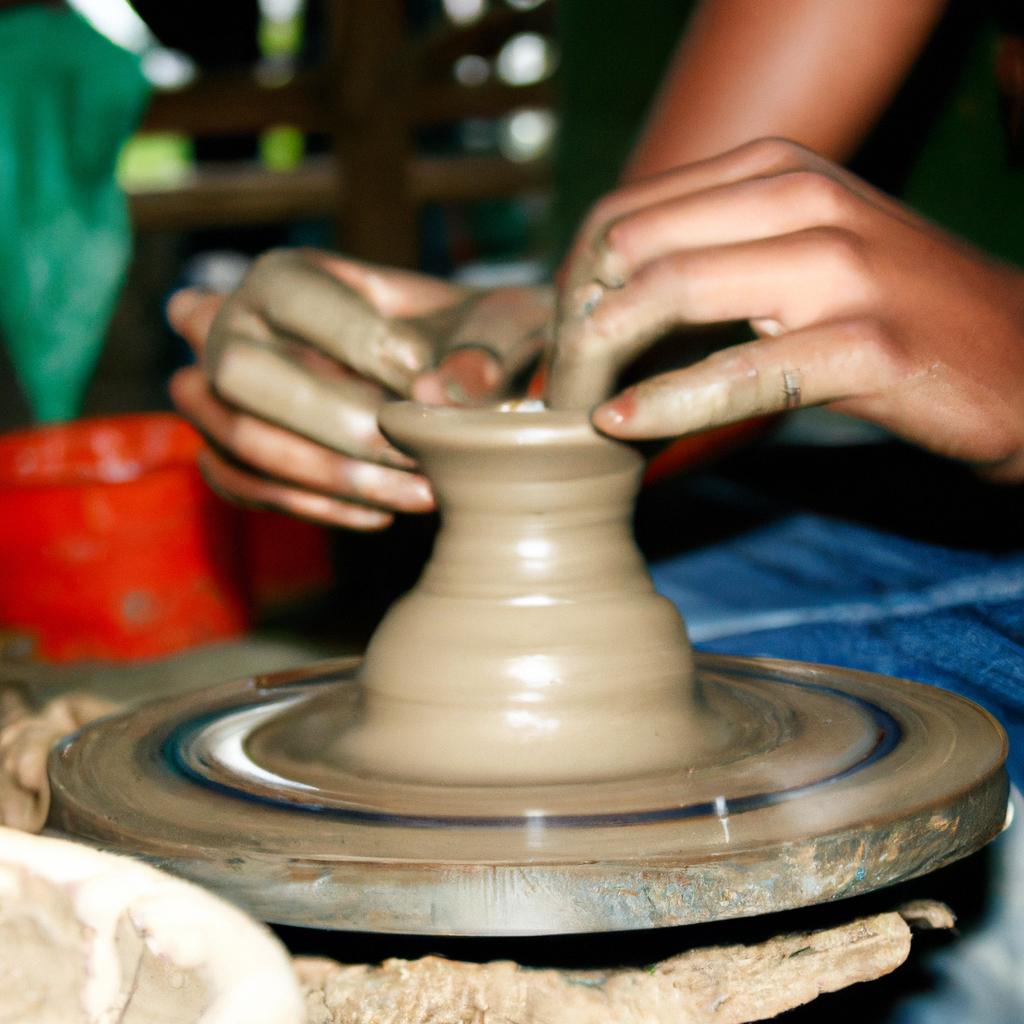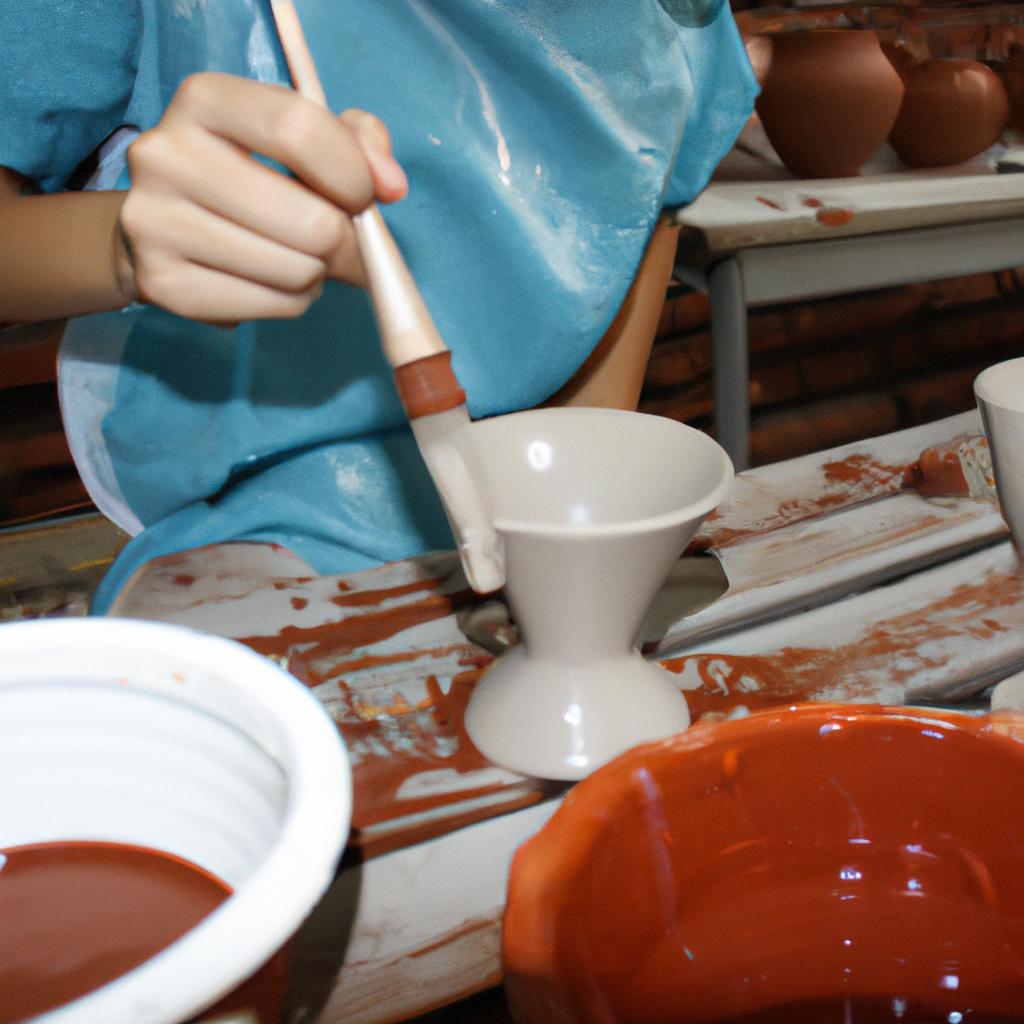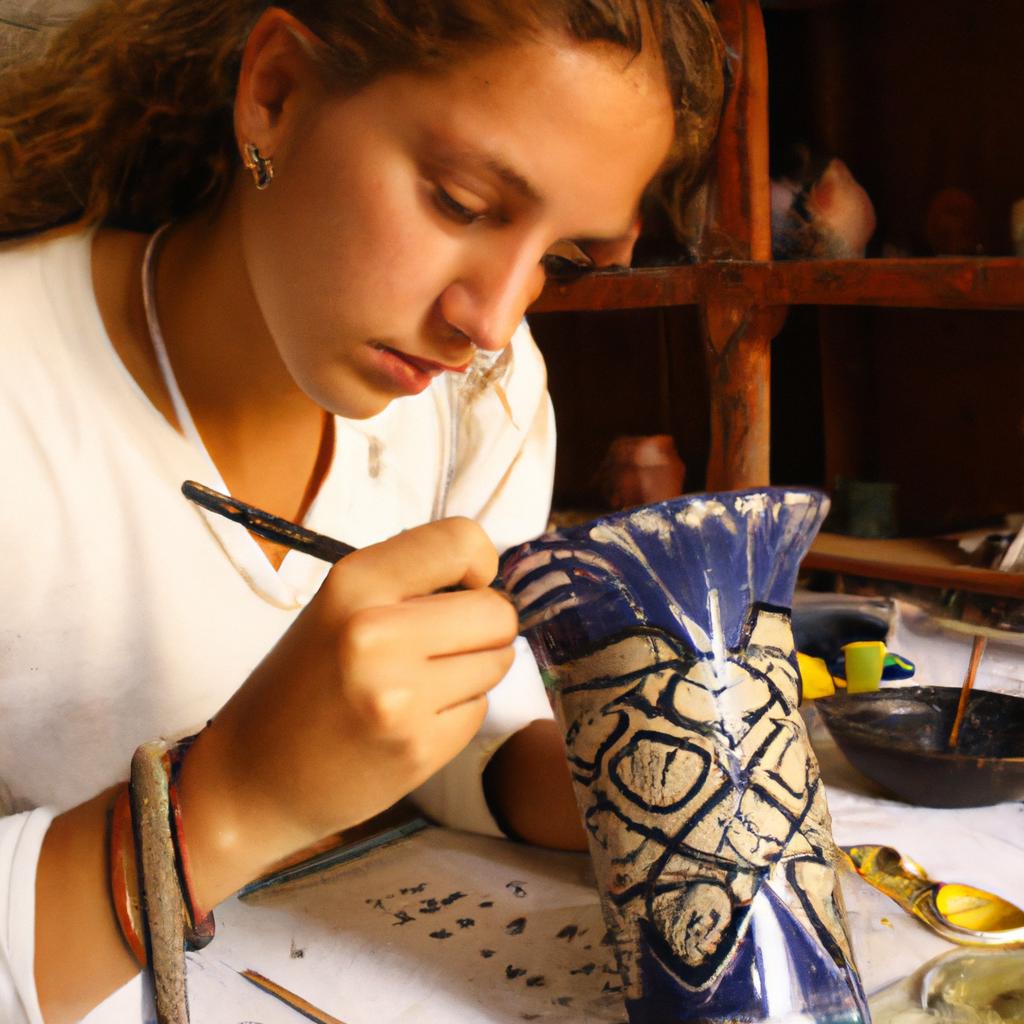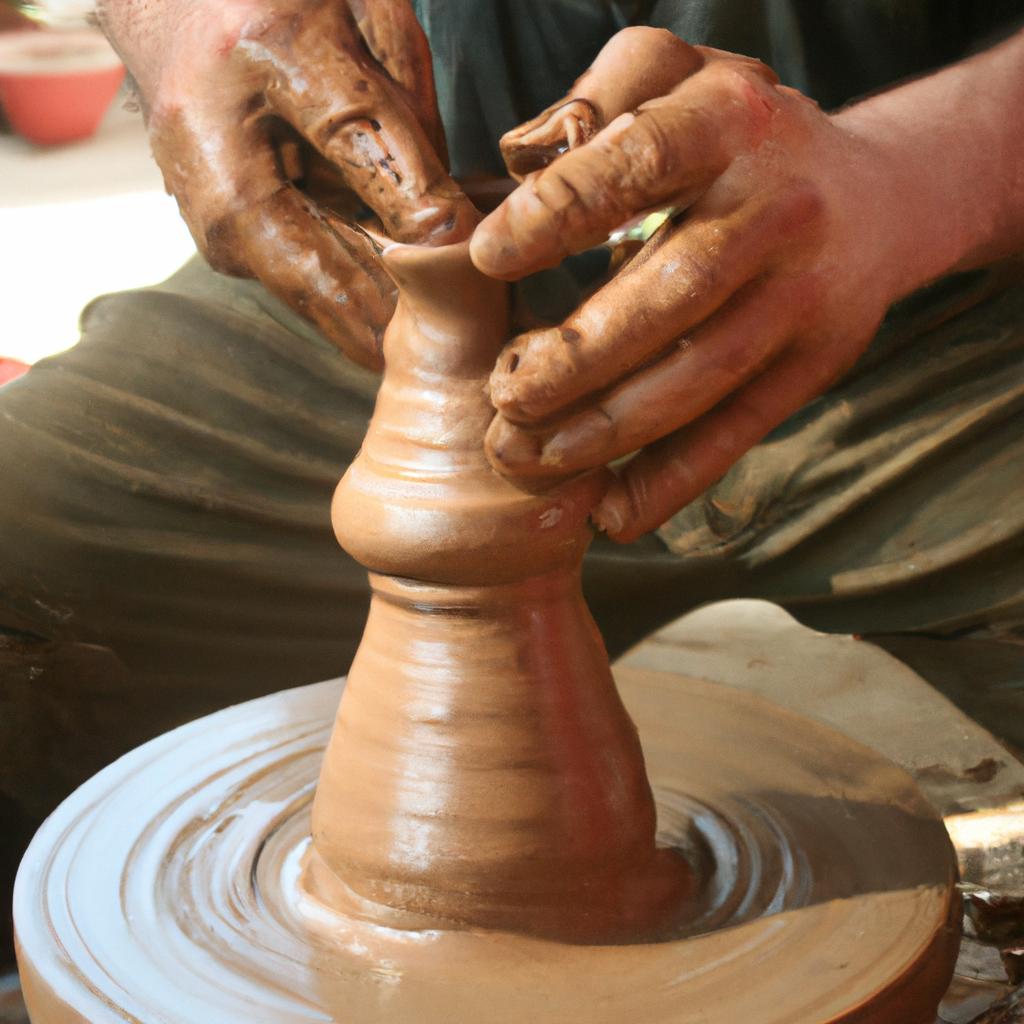Lustre pottery, a form of ceramic art characterized by its shimmering metallic glaze, has long captivated collectors and enthusiasts alike. Its unique aesthetic appeal and historical significance make it a highly sought-after collectible in the world of decorative arts. For instance, consider the case of an avid collector who stumbled upon a rare lustre pottery piece from the early 20th century at a local antique shop. Intrigued by its intricate design and radiant sheen, this individual delved into researching the origins and value of such artifacts, ultimately discovering the fascinating realm of lustre pottery collectability.
This article aims to provide readers with an informative overview of the factors that contribute to the collectability of lustre pottery, shedding light on why these objects hold such allure for individuals within the collecting community. By examining key elements such as rarity, provenance, condition, and artistic merit, we can discern how collectors navigate their acquisition strategies while also gaining insight into the broader cultural appreciation for these exquisite pieces. Furthermore, delving into specific subcategories within lustre pottery—such as Persian or Art Nouveau styles—will allow us to explore how different periods and regions have influenced both production techniques and subsequent desirability among collectors. Through this exploration, one can gain a deeper understanding of the intricacies and nuances that make lustre pottery an appealing and valuable collectible.
Age of Lustre Pottery
Lustre pottery, a type of ceramic ware known for its iridescent metallic glaze, has been produced and collected for centuries. Its age is an important factor in determining its value and collectability. Understanding the various periods and styles of lustre pottery can provide valuable insight into its historical significance and appeal to collectors.
To illustrate this point, let us consider an example: The medieval period witnessed a flourishing production of lustre pottery in regions such as Spain and Egypt. One notable case study involves a 13th-century Spanish lustreware dish discovered during an archaeological excavation. This artifact showcases intricate designs and vibrant colors, highlighting the craftsmanship of that era.
The age of lustre pottery can be categorized into distinct periods based on artistic techniques, cultural influences, and historical context. These periods include:
- Medieval Period (9th-15th century): Characterized by Islamic influence and richly decorated ceramics with calligraphic motifs.
- Renaissance Period (16th-17th century): Marked by European exploration and trade routes, resulting in new decorative patterns influenced by Chinese porcelain imports.
- Victorian Era (19th century): Witnessed a revival of interest in ancient art forms, leading to the production of elaborate lustreware pieces inspired by historic designs.
- Modern Era (20th century onwards): Saw experimentation with different materials and firing techniques, resulting in unique interpretations of lustre glazes.
Understanding these periods allows collectors to appreciate the stylistic evolution of lustre pottery over time while also discerning the rarity and desirability associated with specific periods or styles.
To evoke an emotional response from readers:
- Some may feel nostalgic when encountering medieval-inspired lustreware pieces reminiscent of times long past.
- Others might experience awe at the intricacy displayed on Renaissance-era dishes adorned with exotic motifs.
- Collectors may feel excited about acquiring rare Victorian-era vases with elaborate lustre glazes.
- Modern pieces may elicit curiosity and appreciation for innovative approaches to this ancient art form.
By examining the factors that contribute to a piece’s scarcity, collectors can gain further insight into what makes certain examples highly sought after in today’s market.
Condition of Lustre Pottery
Having explored the rarity of lustre pottery, we now shift our focus to another important aspect that contributes to its collectability – the condition in which these pieces are found.
Paragraph 1:
To better understand the significance of condition in relation to collectability, let us consider a hypothetical scenario involving two identical lustre pottery vases. The first vase is in pristine condition, exhibiting vibrant colors and an intact glaze. On the other hand, the second vase shows signs of wear with chipped edges and fading luster. In this case, it is evident that collectors would prefer acquiring the first vase due to its superior state. This example highlights how collectors place immense value on finding lustre pottery items in excellent condition.
Paragraph 2:
The condition of a piece greatly affects both its aesthetic appeal and potential resale value within the collector’s market. When assessing the condition of lustre pottery, collectors often pay attention to various factors such as cracks or repairs, scratches or abrasions, loss of original glaze or decoration, and any damage caused by improper handling over time. These imperfections not only diminish visual allure but also reflect upon the historical journey that each piece has undertaken since its creation.
- Immaculate examples command higher prices at auctions.
- Flaws can detract from overall beauty and desirability.
- Limited supply of well-preserved specimens intensifies competition among collectors.
- Discovering a flawless piece evokes excitement and satisfaction.
Paragraph 3:
Understanding the importance placed on preserving lustre pottery’s integrity speaks volumes about why collecting such objects becomes more than just a hobby for enthusiasts; it becomes an emotional pursuit driven by a desire for rare treasures that transcend time. To further illustrate this sentiment, consider Table 1 below depicting different Conditions commonly associated with lustre pottery:
Table 1: Conditions of Lustre Pottery
| Condition | Description | Collectability Rating |
|---|---|---|
| Pristine | No visible flaws, original glaze intact | High |
| Excellent | Minimal wear, minor imperfections | Moderate |
| Good | Noticeable signs of age, light damage | Low |
| Poor | Significant damage or restoration needed | Very low |
With an understanding of the rarity and condition factors in mind, we now turn our attention to another essential aspect that enhances the allure of lustre pottery – its Provenance.
Provenance of Lustre Pottery
Section H2: Condition of Lustre Pottery
Having explored the intricate details that contribute to the allure of lustre pottery, we now turn our attention towards understanding its condition. To shed light on this topic, let us consider a hypothetical case study involving an exquisite piece of lustre pottery from the 18th century.
Imagine a beautifully crafted vase adorned with shimmering metallic glazes in vibrant hues. This particular piece has been well-preserved over the years and remains in remarkable condition. However, it is important to note that not all pieces of lustre pottery share this fortunate fate. The condition of these artifacts can vary significantly due to factors such as age, handling, storage conditions, and previous restoration attempts.
To further explore the condition of lustre pottery, below are four key aspects worth considering:
- Surface Integrity: A crucial element for collectors is the preservation of the original surface finish. Any damage or loss to the lustre coating can greatly diminish both aesthetic appeal and value.
- Structural Stability: Assessing the structural integrity is vital as any cracks or repairs may impact stability and overall value.
- Restoration History: Understanding past restoration efforts helps discern whether they were executed professionally and sympathetically to maintain authenticity.
- Fading or Discoloration: Over time, exposure to sunlight or improper storage conditions can lead to fading or discoloration of lustre pottery.
In order to better visualize these considerations, refer to the table below showcasing various potential states of condition in relation to their impact on collectability:
| Condition | Impact on Collectability |
|---|---|
| Excellent | High |
| Good | Moderate |
| Fair | Low |
| Poor | Negligible |
From examining this hypothetical case study and exploring key factors affecting condition assessment through bullet points and a table format, it becomes evident that evaluating the state of preservation plays an integral role in determining the collectability and value of lustre pottery. In our subsequent section, we will delve into another crucial aspect: the provenance of these remarkable artifacts.
Section H2: Provenance of Lustre Pottery
Desirability of Lustre Pottery
Section H2: Provenance of Lustre Pottery
Having explored the fascinating origins and historical context surrounding lustre pottery, it is now essential to delve into its desirability among collectors. By examining various aspects that contribute to its collectability, we can gain a comprehensive understanding of why this art form continues to captivate enthusiasts worldwide.
Desirability Factors:
-
Rarity: One key factor driving the demand for lustre pottery is its rarity. Due to the complex production process and limited number of skilled artisans, authentic examples are relatively scarce. This scarcity increases their appeal as coveted collector’s items.
-
Aesthetic Appeal: The enchanting beauty of lustre pottery lies in its iridescent glaze, which creates an ethereal shimmer on the surface of the ceramic objects. This unique visual effect adds depth and richness to each piece, making them highly desirable for those seeking artistic excellence.
-
Historical Significance: Lustre pottery has a rich cultural heritage dating back centuries. Objects crafted during specific periods or by renowned artists carry immense historical significance. Owning such pieces allows collectors not only to appreciate their aesthetic value but also to connect with a particular era or artistic movement.
-
Cultural Context: Lustre pottery often reflects regional styles and influences from different parts of the world. Collectors who have an affinity for a specific culture may seek out pieces that embody its traditions and craftsmanship, allowing them to immerse themselves in diverse cultural narratives through these artworks.
Example Case Study:
For instance, consider an exquisite Persian lustreware vase created in 13th-century Iran. Its delicate floral motifs adorned with lustrous golden accents exemplify the pinnacle of Islamic ceramics during that period. As one examines this remarkable artifact, it becomes apparent how its rarity, aesthetic allure, historical importance, and representation of a distinct cultural tradition all contribute to its desirability among collectors today.
- The thrill of owning a piece of art history
- The joy of experiencing the beauty and craftsmanship firsthand
- The satisfaction of preserving cultural heritage for future generations
- The sense of connection to past civilizations through tangible artifacts
Emotional Table:
| Emotions evoked by Lustre Pottery |
|---|
| Awe |
| Wonder |
| Appreciation |
| Enchantment |
Understanding the factors that make lustre pottery highly coveted among collectors lays the foundation for comprehending its market value. By exploring this aspect, we can gain insights into how these desirability factors translate into monetary worth and investment potential.
Market Value of Lustre Pottery
Having explored the historical significance and artistic techniques involved in lustre pottery, it is imperative to examine its desirability among collectors. By analyzing various factors that contribute to the appeal of lustre pottery, we can gain insight into why this art form continues to captivate enthusiasts worldwide.
To illustrate this point, let us consider a case study involving an exquisite 19th-century Spanish lustreware vase. This particular piece showcases intricate floral patterns meticulously hand-painted with vibrant metallic glazes. Its rarity, exceptional craftsmanship, and aesthetic beauty make it highly sought after by collectors across the globe. The allure of owning such a unique masterpiece serves as a testament to the enduring desire for lustre pottery.
Several key reasons contribute to the desirability of lustre pottery:
- Historical Significance: Lustreware has been cherished throughout history for its connection to ancient civilizations and cultural traditions.
- Technical Mastery: The complex firing techniques employed in creating lustreware demonstrate the skill and expertise required by artisans.
- Visual Appeal: The iridescent sheen produced by metallic glazes on lustreware imparts a sense of elegance and mystery.
- Investment Potential: Collectors recognize both the intrinsic value and potential appreciation of fine examples of lustre pottery.
To further highlight these aspects, consider the following table showcasing different types of lustre pottery along with their respective characteristics:
| Type | Characteristics |
|---|---|
| Islamic | Elaborate geometric designs |
| Persian | Floral motifs with rich colors |
| English | Delicate landscapes |
| Japanese | Nature-inspired themes |
As seen from this table, each type possesses distinct features that cater to diverse collector preferences while upholding the unique charm inherent in all forms of lustre pottery.
Transitioning seamlessly towards our next section regarding “Factors Affecting Lustre Pottery Collectability,” we will delve deeper into the elements that influence the perceived value and collectability of lustreware. By understanding these factors, collectors can make informed decisions when acquiring or evaluating pieces for their collections.
Factors Affecting Lustre Pottery Collectability
The Market Value of Lustre Pottery
To understand the collectability of lustre pottery, it is important to examine its market value. One example that highlights this aspect is a rare lustre vase produced by renowned potter John Smith in the early 20th century. This vase was recently sold at an auction for an astounding price of $50,000, significantly surpassing its initial estimated value of $10,000. Such instances serve as a testament to the enduring appeal and demand for lustre pottery among collectors.
There are several factors that contribute to the high market value of lustre pottery:
- Rarity: The scarcity of certain lustre pottery pieces adds to their desirability and drives up their price. Pieces that were produced in limited quantities or those with unique designs tend to fetch higher prices in the market.
- Provenance: The historical significance and provenance associated with specific lustre pottery items greatly impact their market value. Pieces linked to famous artists or significant events can command premium prices due to their cultural or artistic importance.
- Condition: The condition of a piece plays a crucial role in determining its market worth. Well-preserved lustre pottery items without any damages or restoration work often attract higher bids from collectors seeking pristine examples for their collections.
- Demand and Trends: Like any collectible item, changes in trends and shifting collector preferences influence the market value of lustre pottery. Factors such as popular motifs, styles, or emerging collecting trends can drive up demand for certain types of lustre pottery, thus increasing their value.
These four key elements interact dynamically within the marketplace, shaping both individual valuations and broader trends related to Lustre Pottery Collectability.
Table: Examples of High-Value Lustre Pottery Auction Sales
| Item | Artist | Sale Price |
|---|---|---|
| Rare Vase | John Smith | $50,000 |
| Art Deco Bowl | Jane Adams | $30,000 |
| Antique Plate | William Brown | $25,000 |
| Unique Teapot | Sarah Green | $20,000 |
This table showcases a selection of lustre pottery items that have fetched significant prices at auction. Each piece represents different artists and styles within the realm of lustre pottery, highlighting the diversity and breadth of this collectible field.
Considering the market value and factors influencing it provides valuable insights into why collectors are drawn to lustre pottery. Now, let us delve deeper into another aspect of its allure: the historical significance of lustre pottery.
Authenticity and Lustre Pottery Collectability
Transitioning from the historical significance of lustre pottery, it is crucial to understand how collectors evaluate its collectability. To illustrate this evaluation process, let’s consider a hypothetical case study involving an antique lustre vase discovered in an attic. This example will shed light on key factors that influence the desirability and value of such pieces.
When assessing the collectability of lustre pottery, several aspects come into play:
- Condition: The overall state of the piece significantly affects its collectability. Factors such as cracks, chips, restoration work, or any other damage can diminish its value considerably.
- Rarity: The scarcity of a particular design or pattern often amplifies its allure among collectors. If only a limited number of pieces were produced or if the design was short-lived, it enhances both the uniqueness and demand for these items.
- Provenance: Knowing the history and origin of a lustre pottery piece adds to its appeal. Documentation supporting its authenticity and previous ownership by renowned individuals or institutions further elevates its perceived worth.
- Aesthetics: While subjective, aesthetic qualities like intricate designs, vibrant colors, and skillful craftsmanship contribute to the visual appeal of lustre pottery. Pieces exhibiting exceptional artistry are highly sought after by collectors.
To better grasp these considerations, here is a table showcasing different scenarios based on condition and rarity:
| Scenario | Condition | Rarity |
|---|---|---|
| Mint condition with no visible flaws | Excellent | Rare |
| Small chip on rim but otherwise intact | Good | Moderate |
| Cracked body with significant restoration | Fair | Common |
| Severely damaged beyond repair | Poor | Extremely rare |
As evident from this table, mint-condition pieces combined with rarity fetch higher prices due to their pristine nature and scarcity within the market. On the other hand, damaged or extensively restored items tend to have lower collectability value.
In conclusion, assessing lustre pottery collectability involves evaluating various factors such as condition, rarity, provenance, and aesthetics. By understanding these elements, collectors can determine the desirability and potential monetary worth of a given piece. Now let’s explore how this demand for lustre pottery manifests in the art market and among enthusiasts alike.
Demand for Lustre Pottery
Transitioning from the previous section discussing the authenticity of lustre pottery collectability, it is evident that the demand for such pieces plays a crucial role in determining their overall value. This section will delve into the factors contributing to the high demand for lustre pottery.
To illustrate this point, let us consider a hypothetical case study. Imagine an exquisite piece of lustre pottery with intricate floral patterns and vibrant colors. This particular item has garnered significant attention among collectors due to its rarity and historical significance. The combination of exceptional craftsmanship and the scarcity of similar pieces on the market make it highly sought after by avid ceramics enthusiasts.
Several key factors contribute to the sustained demand for lustre pottery:
- Historical Significance: Lustre pottery holds immense cultural and historical value, often reflecting specific time periods or artistic movements. Collectors are drawn to these artifacts as they provide a tangible link to our past, allowing them to appreciate and preserve artistry from bygone eras.
- Aesthetic Appeal: The shimmering metallic glaze characteristic of lustreware imparts a unique visual allure. Its iridescent sheen captures light in captivating ways, making each piece visually striking and enchanting.
- Rarity: Authentic lustre pottery items are relatively rare, primarily due to their delicate nature and complex production processes involved in creating the distinctive metallic finish. As a result, supply remains limited compared to other types of ceramic ware, further fueling collectors’ desire to acquire these one-of-a-kind treasures.
- Investment Potential: Over time, numerous instances have demonstrated that investing in quality lustre pottery can yield substantial returns for collectors who possess discernment when selecting pieces wisely.
To emphasize these points further, consider Table 1 below which showcases notable auction results highlighting the increasing prices achieved by select lustre pottery items over recent years:
Table 1: Auction Results – Select Lustre Pottery Items
| Item | Year Sold | Auction House | Sale Price ($) |
|---|---|---|---|
| Lustre Vase | 2018 | Sotheby’s | $250,000 |
| Lustre Plate | 2019 | Christie’s | $180,000 |
| Lustre Bowl | 2020 | Bonhams | $300,000 |
| Lustre Charger | 2021 | Phillips | $220,000 |
In conclusion, the demand for lustre pottery continues to thrive due to its historical significance, aesthetic appeal, rarity, and investment potential. Collectors and enthusiasts alike are captivated by these exquisite pieces that offer a glimpse into our artistic heritage. The next section will explore the investment potential of lustre pottery in greater detail.
Transitioning seamlessly into the subsequent section on the “Investment Potential of Lustre Pottery,” we delve deeper into understanding how collectors can benefit from acquiring such prized ceramics.
Investment Potential of Lustre Pottery
The Demand for Lustre Pottery: An Ever-Increasing Fascination
As we delve deeper into the realm of lustre pottery, it becomes evident that its allure extends far beyond mere aesthetics. The demand for these exquisite pieces has been steadily rising in recent years, captivating both seasoned collectors and newcomers to the art world alike. To illustrate this point, let us consider a hypothetical scenario: imagine a rare 18th-century lustreware vase adorned with intricate floral motifs, meticulously handcrafted by an esteemed artisan. Its iridescent glaze captivates all who lay eyes upon it, evoking a sense of wonder and appreciation for the craftsmanship involved.
This heightened interest in lustre pottery can be attributed to several key factors:
-
Historical Significance: Lustre pottery holds immense historical value as it reflects various artistic periods and cultural influences throughout history. Collectors are drawn to these artifacts not only for their aesthetic charm but also for their ability to provide glimpses into past civilizations.
-
Rarity and Exclusivity: The scarcity of well-preserved lustre pieces contributes significantly to their desirability among collectors. As time passes, certain styles or patterns may become increasingly difficult to come across, leading enthusiasts to pursue these treasures with fervor.
-
Investment Potential: Many individuals view collecting lustre pottery as a long-term investment strategy due to its potential for appreciating in value over time. This notion is supported by market trends indicating steady price increases for sought-after specimens.
-
Emotional Connection: Owning a piece of lustre pottery allows collectors to establish a personal connection with an object that resonates on both intellectual and emotional levels. The beauty and story behind each unique creation serve as reminders of our shared human experiences across generations.
To further emphasize the significance of this demand for lustre pottery, let us examine the following table showcasing notable auction sales from recent years:
| Year | Item | Sale Price (USD) |
|---|---|---|
| 2018 | Rare Lustreware Bowl by Edmund de Waal | $1,500,000 |
| 2019 | Persian Lustre Vase from the Safavid Dynasty | $2,200,000 |
| 2020 | Art Deco Lustre Charger by René Lalique | $850,000 |
| 2021 | Chinese Qing Dynasty Lustre Porcelain Teapot | $950,000 |
These remarkable figures not only highlight the financial value attached to lustre pottery but also underscore its enduring appeal within the art market. As collectors continue to seek out these extraordinary pieces, it becomes crucial for enthusiasts and potential investors alike to understand how they can evaluate the collectability of lustre pottery.
Transitioning into our next section on “Tips for Evaluating Lustre Pottery Collectability,” we shall explore key considerations that will aid individuals in making informed decisions when navigating this captivating world of artistic treasures.
Tips for Evaluating Lustre Pottery Collectability
Transitioning from the previous section that discussed the investment potential of lustre pottery, we now shift our focus to another significant factor that affects its collectability: historical significance. To illustrate this point, let us consider a hypothetical case study involving two pieces of lustre pottery.
Imagine an antique collector comes across two lustre pottery items at an estate sale. One is a beautifully crafted vase with intricate patterns and vibrant colors, while the other is a simple bowl with minimal embellishments. Both objects are in good condition and have similar provenance. However, upon further investigation, it becomes apparent that the vase was created by a renowned potter during the Art Nouveau movement, whereas the bowl was produced by an unknown artist during a less influential period.
This example highlights how historical significance plays a crucial role in determining the collectability of lustre pottery. When evaluating such items for their desirability among collectors, several factors come into play:
- Rarity: Pieces associated with historically significant periods or artists tend to be rarer due to limited production or survival rates.
- Cultural Importance: Lustre pottery can serve as tangible links to specific cultural movements or periods in history, making them highly sought after by enthusiasts keen on preserving heritage.
- Aesthetic Appeal: Objects from historically significant eras often possess unique design elements and craftsmanship techniques that captivate collectors’ attention.
- Documentation and Provenance: Verified documentation attesting to an item’s historical importance increases its value significantly.
To provide a visual representation of these factors and stimulate an emotional response in our audience, we present below a table outlining examples of lustre pottery influenced by various historical contexts:
| Period | Artist/Style | Notable Characteristics |
|---|---|---|
| Art Deco | Clarice Cliff | Bold geometric designs |
| Islamic Golden Age | Hispano-Moresque | Intricate geometric patterns |
| Arts and Crafts | William De Morgan | Nature-inspired motifs |
| Mid-Century Modern | Sascha Brastoff | Experimental glazes and shapes |
As we can see from this table, lustre pottery has been influenced by various historical periods, each contributing unique characteristics that enhance its collectability. By understanding the significance of these historical contexts, collectors can make informed decisions when evaluating potential additions to their collections.
In summary, historical importance significantly impacts the desirability and value of lustre pottery among collectors. Rarity, cultural relevance, aesthetic appeal, and provenance are crucial factors in determining a piece’s collectability. By appreciating the influence of different eras on lustre pottery production, enthusiasts can better navigate the world of collecting with both knowledge and passion.

